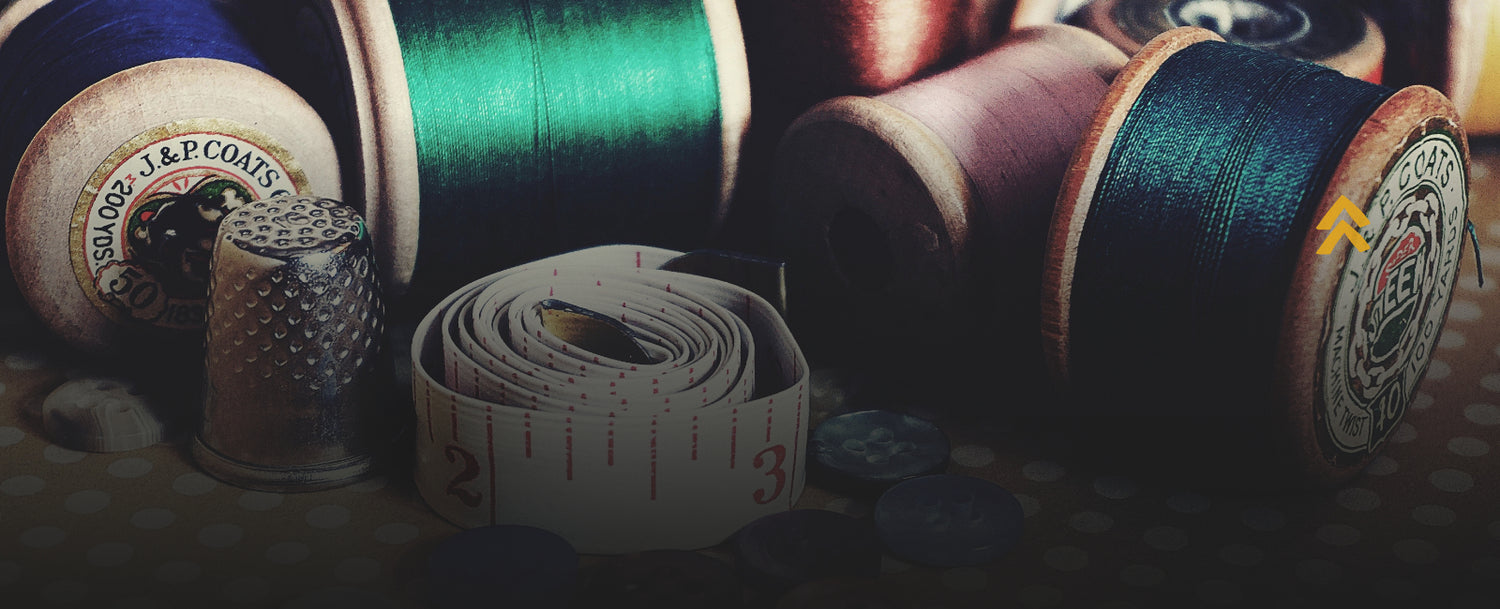1. A good sewing machine
Your sewing journey begins with a good sewing machine that is easy to use and has the necessary features according to your use. Don’t be deterred if you are unable to buy a new sewing machine, as we know they can be quite an investment. If you have access to an ordinary sewing machine that has been at home, or are able to borrow one for practice, that is enough to start! If you wish to make that investment and buy a new sewing machine, it's important to choose a machine that accommodates all your needs. You can read our reviews for the top 10 sewing machines available in India here!

2. Shears or Scissors
Tailor’s scissors or shears are a very important tool for a dressmaker. The best and well fitted clothes start their life cycle as a well cut piece of cloth. When cutting fabric, it is crucial to make sharp and precise cuts. Dull scissors and old shears may cause fraying and damage the fabric that is being cut. Some say, your shears are a sacred tool to the art of sewing. In the olden days, bespoke tailors usually had one pair of scissors that lasted them throughout their career. Sometimes, a retiring tailor passes on the tool to a young artisan of his choosing, a tradition that is still followed by the dressmakers of Savile Row.
So, choose a strong, durable pair of shears, they might end up being your best friend on the job!

3. Iron or steamer
The difference in when a professional tailor makes an article of clothing and when we attempt to do the same at home is miniscule, but rather obvious. The professional takes a few extra steps to make the clothing look divine. The most underrated of the steps is using an iron or a steamer as you stitch your piece. The difference that a pressed seam makes in the finished product is monumental!
So make use of the iron at home to get perfectly laid stitches and seams, and so consider investing in a steamer for ease of usage if you see yourself attempting to sew more dresses!

4. Lighting
Great lighting is a non negotiable for your workspace. If you have access to natural light, make sure to position your workstation in a way that takes advantage of this. If not, a good table lamp will do wonders for your sewing skills.These days, most modern sewing machines come with a built-in light. However, remember to choose a spot with good lighting for all your other sewing activities, like cutting fabric, undoing stitches or sewing buttons or embellishments.
Sewing is a skill that is heavily reliant on one’s eyesight, so remember to take care of it by always using ample light and taking breaks every once in a while so as to not strain your eyes.

5. Rotary cutter and cutting mat
As we touched upon before in the tailoring scissors section, cutting fabrics is one of the most important parts of the sewing process. A rotary cutter is a good investment as it helps cutting pieces with patterns very simple and straightforward. It gives you clear cut lines, especially with lighter fabrics like tulle and chiffon which may be a bit difficult to cut with scissors or shears. A cutting mat is also a good tool to protect your workspace from the inevitable scratches that might occur as a result of cutting or scoring against the surface.
It’s better to be safe than sorry, so don’t skimp out on the cutting mat!

6. Dress form
A dress form is absolutely not a must-have for a beginner sewing enthusiast but it definitely adds some ease if your focus is on dress designing. Dress forms are available in various sizes, materials and can even be modeled after your own body with 3D modelling! If your goal is to create clothes and dresses for different people, an adjustable dress form is also available on the market. Dress forms may seem frivolous, but they give you the best accessibility when adding the necessary finishing touches. They are also a good investment if your goal is to show off your skills online!

7. Pins, pincushion and binder clips
Pins, pincushion and binder clips may not be the first items that will pop into your head when one talks about sewing tools, but they definitely add up in terms of utility. They are useful to keep things in place and help you stay organized. Sewing straight lines takes practice, even on a sewing machine, and bell pins will give you a hand in this aspect. Similarly, binder clips are used for providing a sturdier grip when sewing pieces that are too small to be hand-held or fabrics that are too flimsy.

8. Storage
With learning any hobby or skill in life, organization can help you master it quicker. The same goes for sewing, as it involves many tiny pieces of equipment, as well as important pieces cut from your fabric.Sewing equipment that comes with your sewing machine such as needles, sewing feet and bobbins should be specially taken care of, as they can be quite hard and expensive to replace.
We suggest using a storage box or sectioning a drawer of your cupboard for your sewing projects. Small storage boxes that come with separate compartments are perfect for storing needles, sequins, bobbins and other small sewing equipment.
These boxes are easily available online or even in your local home goods store!

9. Chalk
Tailor’s chalks and pencils are imperative for precise cutting and sewing, and they have the added benefit of being washable! We suggest stocking up on tailor’s chalks as they are cheap, and more useful in your sewing journey rather than normal office stationery, which may damage the fabric you work with. Unlike other tools which have to be maintained and cared for, such as your shears, chalks and other markers are easy to use, easily replaceable and easy to carry! Although it is a small switch, it makes the world of a difference in your sewing journey!

10. Pattern paper
It is fairly easy to replicate your favourite pieces of clothing once you get the hang of sewing. An important but often forgotten tool is pattern paper. Clothing patterns can be made by hand by taking measurements or even tracing our existing clothes.There are various online resources from which patterns may be downloaded and printed as well. Using a roll of pattern paper is simple and easier for a beginner to use rather than trying to tape together small sheets of paper. Moreover, we can find that there are different types of pattern papers that are used for different types of fabric. A finicky fabric like tulle needs a more sturdy pattern while fabrics like silk prefer a lighter pattern paper, such as tissue.

11. Measurement
The most important tool of any seamstress or tailor is their measuring tape. An inch tape is the most versatile tool, and can help you design and create more custom fit clothes.
It’s easy to use and flexible, and you cannot find a single tailor who doesn’t own an inch tape! Apart from inch tapes, if you are into making your own dress patterns, it would be helpful to own a curved ruler, which takes the guesswork out of pattern making and ensures a more professional cut on your final piece!
These are our picks for the top 11 must have tools for a beginner sewing enthusiast. These tools make it easier for you to learn and master the skill, and save you a lot of time and effort.
So hop to the world of sewing & bring your aspiration of sewing your own garments to reality. Start with smaller commitments using pre-cut fabrics & then move on to your favourite fabrics.
Let us know which tool has helped you the most in your sewing journey in the comments below!




